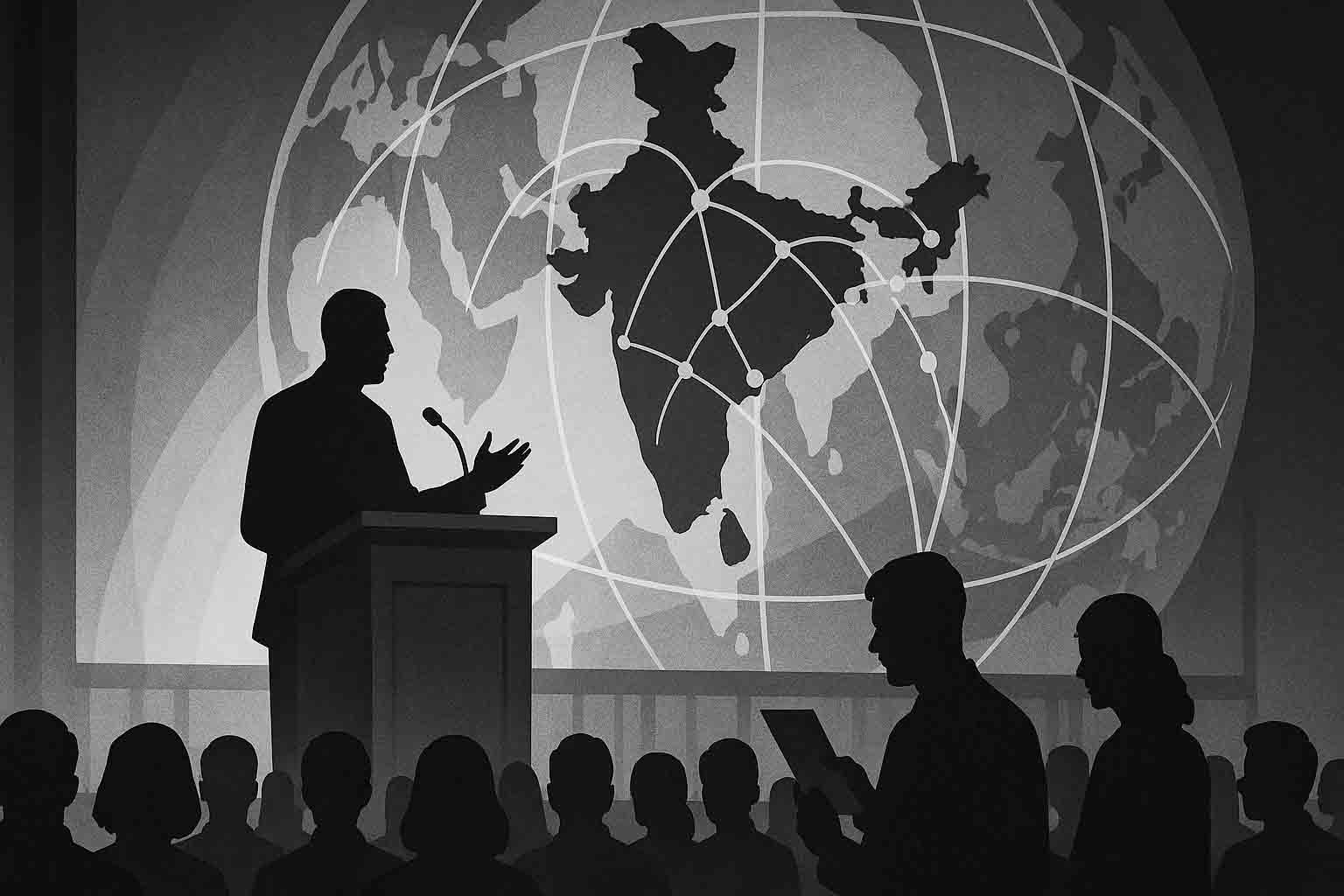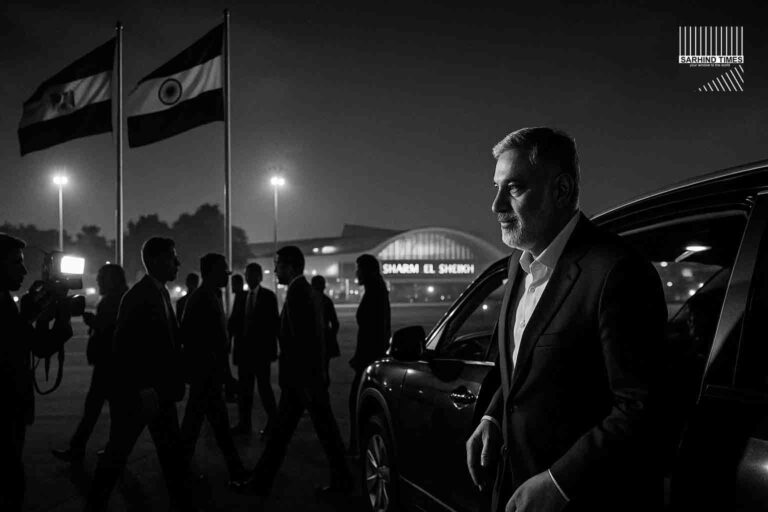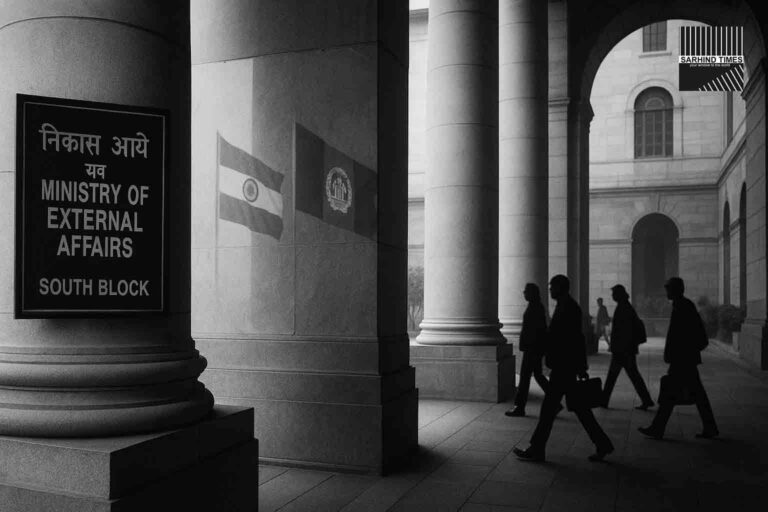New Delhi, October 7, 2025 | Sarhind Times Foreign Desk — At the Aravalli Summit today at Jawaharlal Nehru University, External Affairs Minister S. Jaishankar delivered a forceful call for India to become the default partner for its neighbors in times of crisis. With global volatility rising and geopolitical fault lines becoming more fractious, Jaishankar argued that India’s “Neighbourhood First” policy must evolve from rhetoric to operational readiness — especially in disaster relief, humanitarian response, and regional security. The summit theme, “India and the World Order: Preparing for 2047,” framed this vision in the larger arc of India’s diplomatic trajectory.
The Speech: Bold Lines, Strategic Vision
Speaking before an audience of scholars, diplomats, and students, Jaishankar anchored his address in two intertwined challenges: historical constraints and future opportunity.
He lamented the “strategic diminishing” of India post-Partition, contending that the scars of division imposed limits on regional trust and integration. India must, he said, “underwrite the infrastructure for cooperation” across South Asia and the wider neighborhood to withstand political volatility.
“India has to be the go-to option in any crisis in this subcontinent.”
“In our own region, we have to ourselves underwrite the infrastructure for cooperation if it is to be proofed against political volatility — this is the essence of Neighbourhood First policy.”
He also warned of a world where cooperation is under pressure:
“The world is witnessing more competition and less compacts … the needle has shifted toward weaponisation of everything — supply chains, data, finance, connectivity.”
Jaishankar articulated three internal levers for India’s rise: Demand, Demographics, and Data, arguing that foreign policy must dovetail with India’s evolving domestic capabilities.
At one pointed moment, he addressed diplomatic balance:
“We have multiple neighbours — some are clearly better than others. Hyphenation normally happens with a neighbour who is not so nice.”
He called for de-hyphenation: letting India’s global relationships be shaped on their own merits, not through lens of rivalry with a single neighbor.
The address closed with a summons to institutional and intellectual actors: India must create new ideas, terminologies, narratives as it rises — and not merely follow existing ones.
Why This Matters: Context & Strategic Imperatives
Global Shifts & Regional Fragility
The external environment is increasingly turbulent: trade wars, supply chain shocks, climate disasters, and shifting alignments are raising the cost of inaction. Jaishankar’s invocation of “weaponisation of everything” captures how economic, technological and social levers are being weaponized in geopolitics.
For India’s neighborhood — from Nepal, Bangladesh, Sri Lanka to the Maldives and beyond — crises range from climate vulnerability, debt stress, power shortages, to political instability. If India is perceived as a reliable first responder, its soft power and strategic depth deepen. But to succeed, such a role must be backed by logistics, credible financing, governance systems and cross-border trust.
Neighbourhood First: Theory vs. Practice
Since its articulation, Neighbourhood First has been a recurring foreign policy slogan. But critics often point to gaps between promise and execution: delayed aid, conditionalities, capacity constraints, and geopolitical pushback. Jaishankar’s speech, therefore, attempts to bridge rhetoric and practice.
He insisted that infrastructure for cooperation—energy grids, connectivity corridors, shared institutions—must be indigenously underwritten rather than reactive. That means planning not only for cooperation, but for contingencies when political will wobbles.
India’s Soft Power Assets
Jaishankar’s appeal builds on India’s prior strengths: humanitarian missions (e.g., floods, cyclones), vaccine diplomacy during COVID-19, and infrastructure projects in the region. These have built credibility, but sustaining them in crisis requires forward logistics, predictable finance, trained personnel, and regional institutional frameworks.
Opportunities & Challenges in Operationalizing First-Responder Status
Opportunity: Early Advantage & Strategic Depth
- Prepositioned Assets: Warehouses, medical stocks, logistics bases in neighboring countries can reduce response time.
- Regional Cooperation Frameworks: Collaborations with SAARC, BIMSTEC, IORA for coordinated disaster response.
- Maritime Domain Awareness: India’s strategic location enables monitoring and rapid response in the Indian Ocean region.
- Economic Integration: Power grids, gas pipelines, cross-border trade links build interdependence which also strengthens crisis alignment.
Challenge: Political Sovereignty & Sensitive Balance
Neighbors may balk at India playing savior if offered in a paternalistic or conditional frame. India must navigate national sovereignty sensitivities, local politics, and bilateral mistrust.
Furthermore, funding and sustaining preemptive capabilities is costly. Unless outcomes are visible, they risk being perceived as vanity diplomacy.
Structural Hurdles
- Legal & contractual frameworks: Protocols for consent, customs access, liability in cross-border operations.
- Logistical network gaps: Road/rail connectivity, air corridors, cross-border corridors.
- Institutional readiness: Dedicated agencies, trained rapid response teams, interoperability of command structures.
- Predictable funding: Crisis response requires reserve funds, not only reactionary budgets.
Case Illustrations: Where India Has Acted (and Where It Could)
- Sri Lanka (economic collapse, fuel crisis, 2022–2023): India supplied fuel, medicines, currency support.
- Maldives (COVID vaccination, infrastructure aid): India extended credit lines and vaccine shipments.
- Nepal floods, Bhutan hydropower cooperation: India has long engaged in relief and developmental partnerships.
- Bangladesh drainage and climate adaptation projects: India has engaged in shared flood management, but scaling up would reinforce first-responder posture.
Yet, for many crises—political coups, cross-border insurgencies, debt defaults—the expectations become harder to meet. That tension defines the gap between being a preferred partner and an indispensable responder.
Anticipated Reactions: Neighbors, Analysts & Critics
Neighboring states will watch closely. If India acts more decisively and equitably, it can shift perceptions from heavy-handedness to benevolent leadership. But missteps—bias, conditionality, or neglect—can inflate suspicion.
Foreign policy analysts see the speech as Jaishankar repositioning India’s regional diplomacy in the face of China’s increasing influence. The call to de-hyphenate also signals India’s intent to engage bilaterally rather than being viewed through the prism of Pakistan or China.
Domestic critics may question whether India has the capacity — financial, institutional and logistical — to sustain such ambitions, especially when domestic priorities compete for attention.
Implementation Roadmap: From Vision to Action
To make the “go-to option” a reality, India must pursue four parallel tracks:
- Crisis Capability Centre
A dedicated body or think tank to plan regional scenario projections, pre-positioning logistics, simulation, and crisis financing. - Regional Response Protocols
MoUs with neighboring states for fast-track acceptance of relief, medical missions, air corridors, customs waiver during disasters. - Partnerships & Multilateralization
Pools of regional support through BIMSTEC, SAARC (revitalized), or newer coalitions focusing on disaster resilience and regional infrastructure. - Narrative & Trust Building
Transparent action, predictable rules, and consistent follow-through to build trust that India’s interventions are not transactional but principled.
What to Watch: Key Future Indicators
| Indicator | What It Signals |
| Deployment of India’s disaster relief teams outside India | Operational readiness |
| Budget allocations for regional humanitarian infrastructure | Financial commitment |
| Bilateral agreements for rapid borders access | Institutional readiness |
| Regional perception surveys | Soft power assessment |
| Multilateral platforms endorsing India’s role | Legitimacy |
Excerpts & Voices from the Summit
- Jaishankar: “In our own region, we have to ourselves underwrite the infrastructure for cooperation … India has to be the go-to option.”
- On weaponisation: “Trade calculations are being overturned by tariff volatility … we see a world shifting away from cooperation.”
- On de-hyphenation: “Some neighbours are better than others… decisions by third countries about India should not be based on any single bilateral relationship.”
- On regional policy: He connected Neighbourhood First with Act East, Link West, Focus Africa initiatives as part of extended regional framework.
Conclusion: A Diplomatic Inflection Point
Jaishankar’s summons to make India the go-to option in crises is more than diplomatic posturing: it is a strategic pivot. As the regional axis of influence evolves, India’s quality of capability, legitimacy of action, and consistency of reach will determine whether it transitions from a regional power to a regional anchor.
The true test will lie not in grand speeches but in on-the-ground mission deliveries, ethical execution, and sustainable institutional frameworks. If India can align ambition with actionable readiness, it may well remake the geography of trust in South Asia and beyond.
#ForeignPolicy #Jaishankar #NeighbourhoodFirst #HADR #MEA
#IndiaDiplomacy #RegionalCrisis #SouthAsia #Geopolitics #GlobalOrder

























+ There are no comments
Add yours